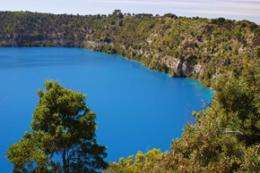Quakes unearth Australia's underground past

(PhysOrg.com) -- Researchers from The Australian National University have used the latest earthquake-measuring technology to image the tectonic plate beneath southeast Australia and reveal for the first time the continent’s geological building blocks.
Scientists from the ANU Research School of Earth Sciences and international colleagues conducted the research through seismometers placed throughout eastern Australia. The instruments – which record ground motions caused by earthquakes as far away as Indonesia, Fiji and Japan – allowed the researchers to probe deep beneath the Earth’s surface and find evidence of some of the key geological events which have shaped the land mass we know today.
Leader of the study, Dr Nick Rawlinson, said that the seismometers have helped reveal some of the secrets which have shaped the Australian continent as well as the planet.
“The southeast of the Australian continent preserves a rich geological history that spans almost half a billion years. This history involves significant geological events like the opening of the Tasman Sea, the break-up of Australia and Antarctica and more recent volcanic events.
“However, until now it has been almost impossible for scientists to unravel the tectonic history of this fascinating part of the continent due to the presence of large, thin cover features such as the Murray-Darling Basin.
“To get around, and below this, we used an Earth imaging technique known as seismic tomography, which is similar in principle to a CAT scan of the human body. This allowed us to recover information from seismic waves generated by distant earthquakes and illuminate the 3D structure of the Earth to a depth of over 250km.
“In southeast Australia this has been done using recordings from nearly 500 seismic stations. The imaging results gave us a detailed picture of the lithosphere, or the crust and rigid portion of the Earth’s mantle, which has greatly enhanced our understanding of the region.”
Dr Rawlinson said that mapping the tectonic plate under southeast Australia led to some interesting discoveries.
“In particular, there is a pronounced anomaly extending at least 150km beneath western Victoria which points to elevated temperatures beneath an area known as the Newer Volcanics province. The region has experienced widespread eruptions until only recently and it is likely that this ‘hot-spot’ is responsible for those episodes.
“We can also see a gradual thinning of the lithosphere towards the east and south coast of the continent which is consistent with stretching related to the formation of the Tasman Sea and the separation of Australia and Antarctica some 80 million years ago.”
Provided by Australian National University


















